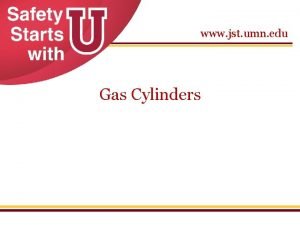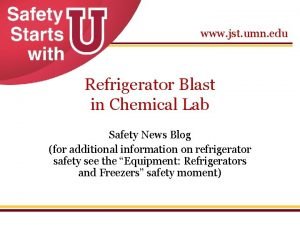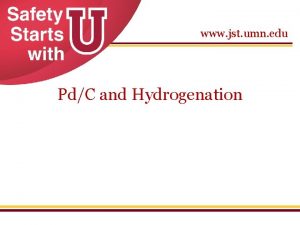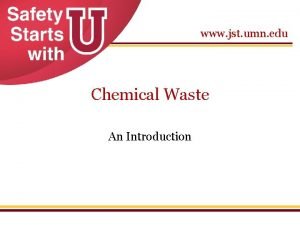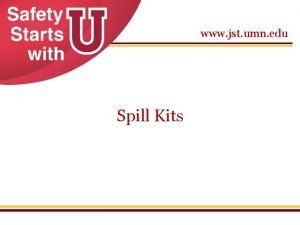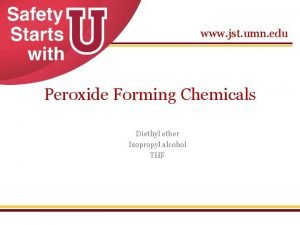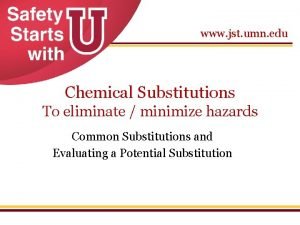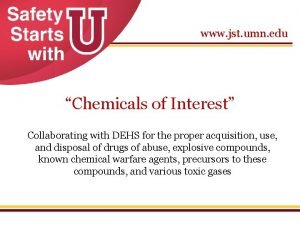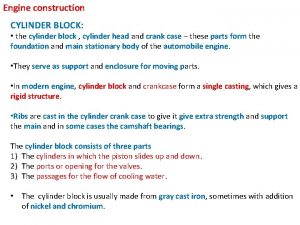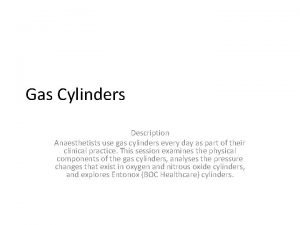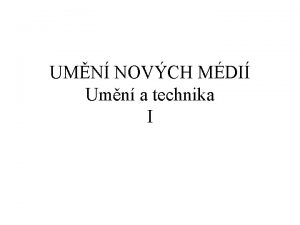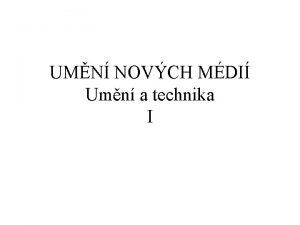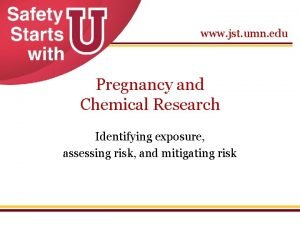www jst umn edu Gas Cylinders Gas Cylinder









- Slides: 9

www. jst. umn. edu Gas Cylinders

Gas Cylinder Safety CASE STUDY 1: • In September 2000, a gas cylinder containing methyl nitrite exploded in a UNR laboratory. • The explosion occurred at night and there were no injuries. • However, there was significant damage to the fume hood. www. jst. umn. edu http: //ucih. ucdavis. edu/docs/i_labexplosion. pdf

Gas Cylinder Safety CAUSES OF THE EXPLOSION: • The cylinder had originally been used to store iodotrifluoromethane and later, nitrosyl chloride. • Possible causes of explosion: 1. Reaction of Methyl nitrite with reactive residues in the cylinder. 2. Internal corrosion due to previously stored chemicals. 3. Leaks in cryogenic transfer system (non-standard system was used) may have allowed liquid oxygen into the cylinder. www. jst. umn. edu http: //ucih. ucdavis. edu/docs/i_labexplosion. pdf 3

Gas Cylinder Safety Lessons Learned: • Never refill gas cylinders with highly reactive or corrosive compounds, including the original compound contained in the cylinder. • Limit the amount of highly reactive, toxic, or flammable chemicals to the quantity necessary for planned experiments. • Do not modify literature procedures (especially those involving highly reactive compounds) without proper technical review. www. jst. umn. edu http: //ucih. ucdavis. edu/docs/i_labexplosion. pdf 4

Gas Cylinder Safety • Damage to the fume hood www. jst. umn. edu http: //ucih. ucdavis. edu/docs/i_labexplosion. pdf 5

Gas Cylinder Safety • Compressed cylinder video www. jst. umn. edu http: //ucih. ucdavis. edu/docs/i_labexplosion. pdf 6

Gas Cylinder Safety CASE STUDY 2: • In 2008, a graduate student researcher took the 20 ml of waste methanol to a fume hood to dispose of it into the waste solvent bottle (500 ml, amber glass container). • The researcher mistakenly added the waste methanol to the nitric acid waste bottle (500 ml, clear glass container). • Both waste bottles were correctly labeled. • Shortly after adding the alcohol to the acid waste, the acid waste container exploded. www. jst. umn. edu http: //ucih. ucdavis. edu/docs/i_labexplosion. pdf 7

Gas Cylinder Safety CASE STUDY 2: INJURIES • His injuries included glass lacerations to the face and arms, with limited acid burns. He also sustained non-permanent injury to his right eye (he was not wearing safety glasses or goggles). www. jst. umn. edu http: //ucih. ucdavis. edu/docs/i_labexplosion. pdf 8

Gas Cylinder Safety CASE STUDY 2: CORRECTIVE ACTIONS • Researcher admits to not having paid attention during waste disposal. • Corrective action taken: 1. Acid waste containers are now placed separately from solvent containers. 2. Containers are now color-coded to indicate different classes of chemicals. 3. Glass bottles now need to be placed in plastic containers. www. jst. umn. edu http: //ucih. ucdavis. edu/docs/i_labexplosion. pdf 9
